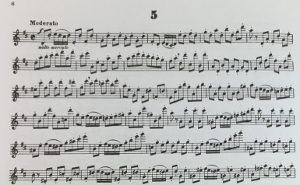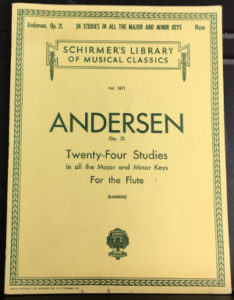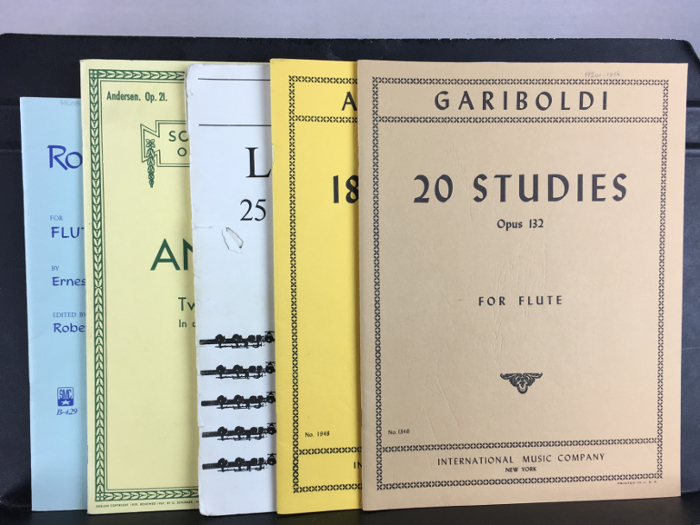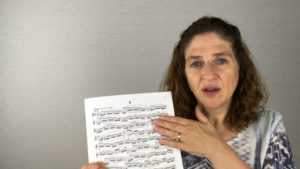That’s no joke. When my teacher had finally and fully impressed upon me the importance of etudes in my development as a flutist, I decided to treat them like solos. I worked hard and quickly began to learn much more about music, including concentration, phrasing, cadences, playing without mistakes, and practicing. It was such an eye-opening experience, and quite a difference from my past interactions with etudes. All of a sudden, I had a reason to practice etudes: they clearly helped me become a better flutist.
This still holds true today.
It was a trans-formative time for me because of these magical and mysterious studies commonly called etudes. And they can transform you too, if you’ll let them. Well that’s not completely accurate. You have to make them.
So, let me share with you some ideas about etudes that may change the way you think about them. However, I will warn you that once you swallow this pill, you will never just want to “get through your etudes” ever again.
The first time that I assign an etude to one of my new students, I don’t give them much instruction. I want to see what they know, or more to the point, what they’ve been taught before they reach me. When they come to their next lesson, I become totally aware of where they’re at musically and flutistically. Whether they’re in high school or college, I’ve found their ability to perform an etude is always lacking. Invariably, they’ve taken on this etude as if it’s drudgery that needs to be gotten through before they can get to their fun solos.
I’m here to tell you that etudes can be the goal, not just the path to your goal. In fact, etudes can be just as satisfying to practice as solos because an etude is basically a solo for flute alone. When I’m done teaching my students how to practice etudes, their eyes are opened and they begin to practice etudes with fresh attitudes and vigor.
So, how does one approach an etude?
Well, the way you approach an etude is to learn how to practice an etude. I’ve published a blog and made simple 8-minute video titled “How to Practice Etudes” where I describe the steps you take to practice etudes to get them to the tempo that you want, and to be able to play all the way through with confidence and with concentration without making mistakes. This is actually the same process that I use today to attack any really technical passages including my solos.
Learning the technical aspect of etudes is also a way to begin to hear where the melody lays within the technique, and where the cadences are in a piece. There’s always a melody, but not always the same type of melody. In some etudes, the melody is not easily found. In other etudes there’s more of a rhythmic motive. But in my favorite etudes, the melody is like a tiny jewel sitting amongst the technique, just waiting for you to discover. And I love helping my students discover that hidden melody for the first time.
My favorite etudes to discover these beauties are the Anderson etudes. I start my students with op 41 and go from there. I especially like opening my younger students’ eyes with no 2 in op 41. There are hidden melodies in all the staccato tonguing that only reveal themselves by diligence and perseverance. It can be hard work. “But with anything worth having, there’s a price you have to pay.” So, I have them play it for me. Then I’ll watch their chagrined looks as I show them the hidden gems that they didn’t hear the entire week of practice.

This is a good time to teach phrasing and cadences. It is not a given that a student who auditioned for college and sounded good enough to be accepted, actually knows about phrasing. I have learned not to take anything for granted. First take the piece apart. When a student learns the melody, and can play it with the knowledge of where the phrase is going, and how to cadence properly, then we are ready to put the piece back together.
Then I have the student play the melody notes, making sure to phrase and cadence while I play all the notes. Then we switch. This way of learning about cadences gives an etude an entirely new appearance to the student. The next week the student smiles when I ask them to play it, rather than giving me that worried look.
When you are up to the challenge, try Anderson op. 15. These melodies are fantastic and raise your technique to a new level.
It is amazing the progress students make when they have learned to how to practice an etude AND how to play technically and musically at the same time. From there, it’s a short hop and a skip to take what they have learned into their solos.
Concentration is another fantastic thing to practice when working on etudes. How many times in your life (and mine!) have you performed and:
1. After the performance thought “wow I don’t even remember playing that part?”
2. Allowed a mistake to derail your psyche?
3. In performance played mistakes you have never played before, or played the mistake that you have been working on for months and thought you had conquered?
That was me, and it still can be me if I don’t take hold of my own learning adventure.
Etude practice can help with this. Any etude can be used. But, I like to use the longer Anderson etudes for this kind of practice. Op 15 is a good place to start but where ever your skill level is play your etude with this in mind. When practicing etudes as I’ve mentioned in my video you need to place x’s on difficult measures. This means that it’s a measure or section that you need to practice individually.
After you have learned these hard parts individually, the next thing is to learn to play through these areas. Begin by adding a measure before and a measure after. If you can do that in tempo, then add a few more measures in both directions. Don’t allow yourself to stop. Keep your mind on playing perfectly knowing that you have learned this difficult spot. This is the best method for teaching yourself concentration and perfect playing. Your ultimate goal is to turn on your metronome to the tempo you are up to, and then play from beginning to end with no stopping and no mistakes. I learned so much about myself and my inabilities doing this.
There are many etudes out there that are worth their salt and many can be downloaded from IMSLP for the cost of membership. Here are just a few etudes that are worth your while:
Kohler op. 66 Romantic Etudes
Druet Etudes
Anderson op. 41, op. 33, op. 21, op. 15 and op. 60
Jean Jean Studies
Piazzola Tango Etudes
There are many other etudes that can be useful in developing your musical and technical skills. But these are my favorites.
Have fun developing your musical and flute skills with etudes. Learn to enjoy this practice time. It’ll do you a world of good.
DoctorFlute

FluteTips 99 Playing Köhler’s Virtuosic Etudes Opus 75

Practice with Me Dolls Waltz Köhler 25 Romantic Etudes Op 66 No 2

Everything I Learned About Music I Learned in a Etude!

FluteTips 14 Practicing Etudes


